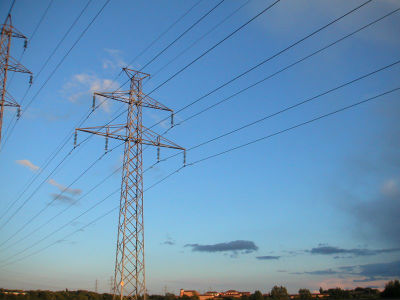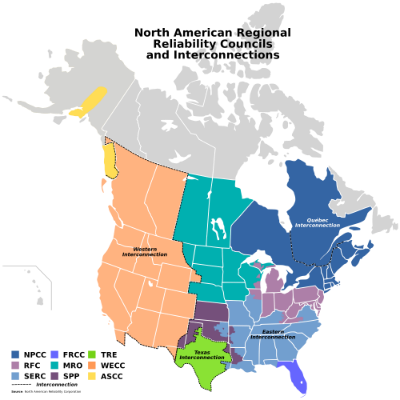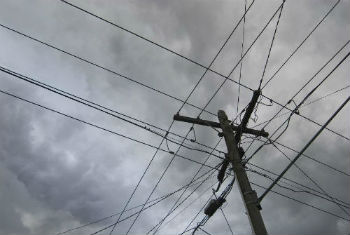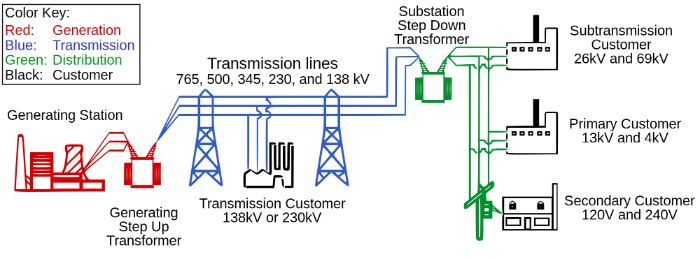What is the Electricity Grid?

Electricity. You use it every day – to heat and cool your home, for light, communication, entertainment, and more. These days, you may even use it to run your car. Electricity has become so important to our world that it’s almost a basic necessity, like water or air.
Like many basic necessities, it’s something that we often take for granted. How often do you think about electricity (other than during a power outage)? Though we don’t think about it often, the system that brings electrical power to your home is pretty impressive.
That system is called the electricity grid. The term refers to the network of high voltage power lines and overhead transmission lines that link power generation facilities to the homes and businesses that use electricity. On a national scale, this network is huge: there are over 450,000 miles of high-voltage power lines and over 160,000 miles of overhead transmission lines throughout the United States.
What’s even more impressive than the size of the power grid is the delicate balance it manages to constantly maintain between demand and supply. Because large amounts of electric energy can’t be stored, electricity has to be produced and delivered in real time. This means that the power grid operators must respond immediately to any shifts in power demand or supply so that electricity is generated and delivered to where it’s needed.
The electric power grid must also evolve constantly to adapt to our changing needs for power. Technological innovations have brought us the possibility of producing our own power and selling it back to the grid, or leaving the grid entirely. Advances in technology are also helping us change the way we manage the grid so that it can be more energy-efficient.
In this article we explain what the electric power grid is, and how electricity is delivered to your home.
How Does Electricity Make it to Your Home?
The entire electricity process, from generation to final use, can be broken down into four main steps, namely, electricity generation, transmission, distribution, and final end use.
Electricity Generation
How is electricity generated?
The first step in the process of bringing electricity to your home is to generate it. Most electricity is generated by movement, and involves the use spinning turbines. Most of the time these turbines are moved by steam, which may be created by burning coal, natural gas, nuclear energy, or oil. But the turbines can also be moved by water, in a hydroelectric dam, or by wind.
Did You Know?Electricity can also be generated by photovoltaic panels, which convert light from the sun directly into electricity, or through electrochemical reaction (though it is mainly used for energy storage – i.e. batteries – and not as a source of electricity). However, both of these forms of power generation are used for getting electricity off-grid, and not considered part of on-grid electricity.
Each power generation source comes with its own set of advantages and challenges, in terms of how they can be used to meet demand for electricity. This is part of the reason why most states don’t rely on just one single source for their electricity supply. For example, power plants fueled by coal and nuclear energy are difficult to ramp up or down, meaning that they usually run constantly round the clock regardless of the amount demand for electricity. This makes them a popular option to provide a “base load”, but as electricity demand changes depending on the time of day, other sources of power may be required to ensure that there is electricity supply available at all times.
The physical environment might also make some power sources more appropriate in some areas than in others. This is most obvious with many sources of renewable power: for example, wind power makes sense in areas such as Texas where there are wide spaces that receive high winds, but is less appropriate in places of high density that might experience storms such as in Florida.
Finally, but certainly not the least important, all sources of electricity generation pose different opportunities and challenges in terms of their impact on the environment and on human health. Electricity production is the single largest source of greenhouse gas emissions in the US, contributing to 31% of all GHGs emitted in the US in 2013. While advances in technology are making renewable energy cheaper and easier to deploy on a wide scale, the vast majority (67%) of electricity in the US comes from fossil fuels. Find out more about the pros and cons of different electricity generation sources in our guide.
Whatever the source of movement, the process of generating electricity is the same: the rotation of turbines generates mechanical energy, which then moves magnets across copper coils, causing electrons to move and generating an electric current. Most commercial electricity generators produce 3-phase alternating current (AC) power.
Who is involved in electricity generation?
Depending on where you live in the United States, electricity generators in your state might be owned by electric utility companies, or by independent power producers (IPPs), or by a combination of both. In a regulated electricity system, one electric utility company owns and operates the generation facilities in a certain service territory, but is regulated by an independent regulatory agency appointed by the state legislature, known as either a Public Utility Commission (PUC) or a Public Service Commission (PSC). Generators can only be built with approval from the PUC/PSC, and charge rates according to what these agencies have approved.
In an electricity system that is open to competition, independent power producers are allowed to generate and sell electricity on the grid. IPPs sell electricity to end users (or their agents), and the electric utility delivers this electricity along the electricity transmission and distribution lines and wires. The electricity utility company in this case is the owner and operator this electricity delivery system, which covers the next two steps of the electric service.
Electricity Transmission
What is electricity transmission?

Electricity transmission is the transportation of electricity over long distances at high voltages
As most power generation happens in places far from its end users, electricity must travel large distances to get to where it is eventually used. For this travel it is transformed to a high voltage, typically in the range of 110 to 765 kV (kilovolts), as less energy is lost due to resistance at high voltages. This high voltage electricity travels along transmission lines, which are either overhead power lines or underground power cables. Overhead power lines are more common, as they are much cheaper and less intrusive to construct, but can be affected by poor weather (such as high winds or low temperatures).
Transmission lines throughout the US are highly interconnected. This helps make the grid more reliable, as it offers grid operators more flexibility if there is an interruption in supply or a dramatic change in demand for electricity at any given point in time.
There are three main transmission networks (“interconnections”) across the United States: the Western Interconnection (which is west of the Mississippi River), the Eastern Interconnection (largely east of the Mississippi River) and the Texas Interconnected System (which covers most of Texas).
Who is involved in power transmission?

Most interconnections cross national as well as state boundaries; only Texas has its own interconnected transmission system.
Because it doesn’t make sense (economic or otherwise) to have multiple transmission wires competing to be used, one electric utility company owns and operates the wires within a certain territory. This is the case throughout the United States, in both deregulated and regulated electricity markets. However, these companies’ rates are regulated by the state PUC/PSC. New transmission lines must also be approved by the state regulatory body (the PUC/PSC) before being built.
Electricity transmission networks might be managed by the utility company, if the local electricity market is regulated and closed to competition. But in deregulated markets, a separate entity, known as an Independent System Operator (ISO) or Regional Transmission Organization (RTO), provides generation supply access to transmission by scheduling and monitoring the use of transmission lines.
Because it is possible for electricity to be bought and sold across states, this part of the grid can also come under the regulatory oversight of a national agency called the Federal Energy Regulatory Commission (FERC). Among other responsibilities, the FERC makes sure the transactions between electricity buyers and sellers are done legally. In regulated areas, FERC regulates the prices of electricity sold on the wholesale market, and makes sure these prices are fair. The agency also is responsible for permission for constructing new transmission lines.
Electricity Distribution

Electricity distribution is the delivery of electricity to your home
The distribution step of electricity service covers the local delivery of electricity along the wires in your community to your home. As the voltage that electricity travels along is too high and dangerous to be used, it must be “stepped down” to a lower voltage that is suitable to travel along the distribution grid. This transformation takes place in a power substation. Once electricity is stepped down to a lower voltage, usually to about 50 kV or lower, it travels along the local distribution network. The distribution network is made up of the wires and poles that bring electricity to your home. Before electricity reaches your home, however, it is transformed one more time to 240 V, which is the normal voltage for household electrical service.
Who Owns Power Distribution?
The electricity distribution network is owned and operated by your local electric utility company, which is responsible for ensuring the reliable and safe delivery of electricity to your home. Part of their services also includes meter reading and maintenance, as well as responding to outages. This step in the electricity service is also regulated, by the PUC/PSC for your state. They approve the rates for electricity delivery.
Consumer Use

The final stage of the electricity service is when it reaches your home
The final step of your electricity service is when it reaches your home and you use it. Electricity enters your home through a meter, which measures your consumption so that your electricity company can charge you for your electricity use. In the past this meter was an analog meter, and a representative from your utility company came to your home about once a month to take a meter reading. Today, with the nation upgrading to smart grid technology, millions of residential meters have been replaced with smart meters. These meters are able to communicate your usage information directly to the utility, making for more accurate recordings of your usage and helping make the grid more efficient.
We use electricity for a lot of things, but our needs for electricity change throughout the day, which is why grid management is so complicated and important to our everyday lives. The importance of effective grid management was dramatically illustrated with one of the largest blackouts in recent history in August 2003, which affected 50 million people across New York, Pennsylvania, Connecticut, Massachusetts, New Jersey, Michigan, and parts of Canada. Caused by a combination of human error and computer malfunctions, in some cases power wasn’t restored for two days.
Find Out MoreWhat is peak demand?
Time of Use Pricing Explained

Image source: Wikipedia
Actors
When your meter is read and you receive a bill for your monthly consumption, you are charged for two things: the cost of delivery, and the cost of the electricity itself. How much you pay for your power supply and from which company you purchase it from depends on whether the retail electricity market in your area is open to competition.
In regulated markets, your electric utility company is also your electricity supplier, meaning that they purchase/generate electricity on your behalf and charge you accordingly. In this case the utility’s rates for electricity supply will be regulated by your state PSC/PUC, as is the case for delivery.
In areas where the electricity market has been opened to competition, you may still have the possibility of purchasing electricity from your utility, but you will also have the option of purchasing power from an alternate supplier. Rates from your utility will be regulated by your PSC/PUC, but rates from alternate suppliers are unregulated. However, all suppliers are required to hold energy licenses and be recognized by your state PSC/PUC in order to be able to do business. They must follow certain criteria for sales practices and behavior, or else risk losing their license.
Regulated vs Unregulated Power Prices
Regardless of whether you are purchasing electricity from your utility or from an alternate supplier, you are paying for the same service: for your utility/supplier to purchase electricity on your behalf. Utilities, whose prices are regulated, may be required to follow a certain purchasing procedure that has been approved of by your state PSC/PUC, and can only offer one “type” of price, which is usually a variable one (where the price per kWh changes regularly). Alternate energy supply companies, on the other hand, make profit on the electricity they sell, but are not fixed to following one energy purchasing process. They are also allowed to offer a wider variety of price options, including fixed, variable, and indexed prices.
How Has America’s Electricity Grid Evolved Over Time?
The electric grid has changed dramatically since its origins in the early 1880s. In the early 20th century, over 4,000 individual electric utilities operated in isolation, and most of them used low-voltage, direct current (DC) connections from nearby generating power plants. However, thanks in part to businessman George Westinghouse and inventor Nikola Tesla, electric companies began to favor the alternating current (AC) system, which had the distinct advantage of allowing high voltages to be carried long distances (which would then be stepped down to lower voltages for customer use). With widespread use of AC electricity, the electricity industry could build larger power plants that did not need to be located close to the utilities' customers.
Evolutions in Electricity Regulation
The capital costs involved in constructing larger generation plants and transmission distances favored larger companies, and in most areas one company controlled all of the steps of the electricity service, from generation to retail sale. To stabilize the business environment, these “natural monopolies” were regulated by state authorities, which placed limits on the rates that utilities could charge.
This regulated monopoly system for electricity service was in place throughout the United States starting from about the 1920s. However, starting from the 1970s, the combination of advancements in technology and certain stresses on the power service system led some to consider restructuring.
Competition in the electricity service first began after the energy crises during the 1970s, when Congress allowed wholesale competition in electricity production and for the existence of independent power producers (IPPs). At this time, advances in generation technologies meant that smaller-scale generation (mainly generation from renewable sources like wind and hydropower) was possible.
Allowing competition in the wholesale market for electricity was the first step in breaking the “vertical monopoly” that utilities companies enjoyed in the electricity market. Starting in the 1980s and 1990s, state policy makers began to take a look at what was happening in other former monopoly-dominated sectors (like telecommunications and aviation) and seeing if it could be applied to the electricity sector. Throughout the 1990s and early 2000s, 17 states (plus the District of Columbia) decided to restructure how the electricity grid was managed, allowing customers to buy electricity from competitive retail suppliers.
Challenges to the Electricity Grid Today
After years of under-investment, one of the biggest challenges facing the electric power grid today is how to adapt an aging infrastructure to a rapidly changing demand; while electricity use increased by 58% between 1980 and 1999, investment in transmission infrastructure declined by nearly half during the same time period. Today, around 70 percent of the power grid’s transmission lines and transformers are over 25 years old, yet our needs for electricity is as important as it has ever been, placing even higher stress on the grid.
Some other challenges to the electric grid include:
- Finding a way to site new transmission lines where there is opposition to construction
- Determining fair cost-recovery agreements when new transmission construction happens in one state but benefits other states
- Finding ways to integrate greater renewable energy generation (such as wind farms and solar panels) into the power generation mix when it is often located far away from demand
- Increasing the resiliency of the power grid against storms and severe weather, and keeping it protected from physical and cybersecurity attacks
New Opportunities on the Power Grid
Fortunately, the electricity grid is evolving thanks to new technologies that can prevent/shorten outages, improve energy-efficiency, and encourage the integration of clean power onto the grid. Here are just a few innovations that are helping the electricity grid adapt to a changing world.
Energy Storage
One of the current major challenges in the electricity service process is that electricity must be generated and delivered in real-time and grid operators must respond quickly to rapidly changing demand. This is a particular challenge for integrating greater renewable electricity, which is often intermittent or unavailable when power demand is high. Advances in energy storage technologies (batteries) could allow electricity to be stored for use when electricity demand increases rapidly, which would increase energy efficiency, reliability, and the development of a “clean grid”.
Smart Meters
Smart Meters allow for two-way communication between consumers and the utility, alerting utilities of power outages more quickly, and providing consumers with more data that they can use to improve their energy efficiency at home. Find out more about smart meters in our guide.
Microgrids
A microgrid is local energy grid that has the capacity, in the event of a disruption on the traditional grid, to disconnect from it and operate autonomously. They also can reduce the distance that electricity has to travel, which increases efficiency and saves money.